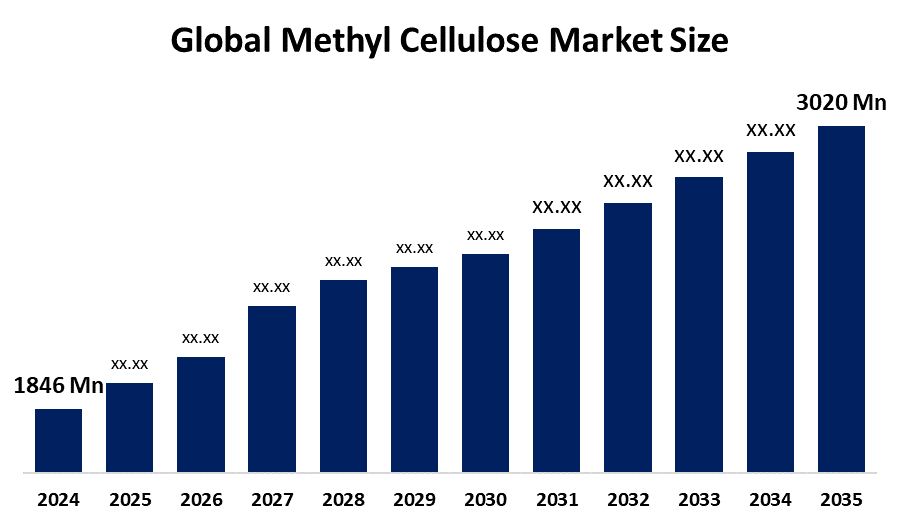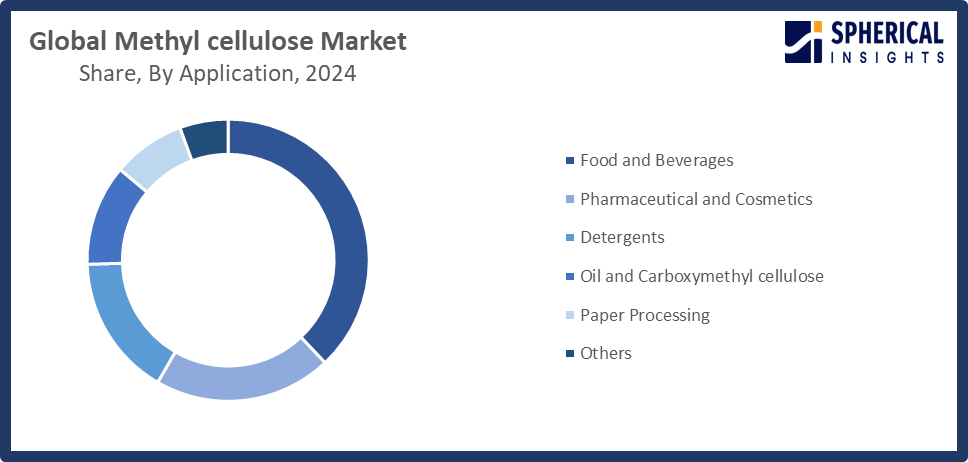Global Methyl Cellulose Market Size, Share, and COVID-19 Impact Analysis, By Type (Carboxymethyl Cellulose, Ethyl Cellulose, Ethyl Methyl Cellulose, Hydroxypropyl Cellulose, Hydroxyethyl Cellulose, and Others), By Application (Food and Beverages, Pharmaceutical and Cosmetics, Detergents, Oil and Carboxymethyl cellulose, Paper Processing, and Others), and By Region (North America, Europe, Asia-Pacific, Latin America, Middle East, and Africa), Analysis and Forecast 2025 - 2035
Industry: Chemicals & MaterialsGlobal Methyl Cellulose Market Size Insights Forecasts to 2035
- The Global Methyl Cellulose Market Size Was Estimated at USD 1846 Million in 2024
- The Market Size is Expected to Grow at a CAGR of around 4.58% from 2025 to 2035
- The Worldwide Methyl Cellulose Market Size is Expected to Reach USD 3020 Million by 2035
- North America is expected to Grow the fastest during the forecast period.

Get more details on this report -
According to a Research Report Published by Spherical Insights and Consulting, The Global Methyl Cellulose Market Size was worth around USD 1846 Million in 2024, Growing to USD 1930 Million in 2025, and is predicted to Grow to around USD 3020 Million by 2035 with a compound annual growth rate (CAGR) of 4.58% from 2025 to 2035. The food, construction, and pharmaceutical industries' growing demand, together with growing consumer awareness of sustainable products and developments in formulation technologies, are driving opportunities for expansion in the methyl cellulose market.
Global Methyl Cellulose Market Forecast and Revenue Size
- 2024 Market Size: USD 1846 Million
- 2025 Market Size: USD 1930 Million
- 2035 Projected Market Size: USD 3020 Million
- CAGR (2025-2035): 4.58%
- Asia Pacific: Largest market in 2024
- North America: Fastest growing market
Market Overview
The global manufacturing, distribution, and use of methyl cellulose (MC), a versatile, water-soluble cellulose ether produced by chemically modifying plant-based cellulose, are all included in the methyl cellulose market. Since methyl cellulose has special qualities including thickening, emulsifying, film-forming, and stabilizing, it is utilized extensively in a variety of industries, including construction, pharmaceuticals, food and beverage, cosmetics, and personal care. Government programs that encourage market expansion by providing incentives for green formulations include the U.S. Food and Drug Administration's support for pharmaceutical manufacturing and food security, and the European Union's strict regulatory frameworks encouraging eco-friendly additives.
A growing number of working professionals, growing awareness, and a thriving construction industry are the main drivers of the methyl cellulose market. The growing food industry, which uses methyl cellulose as a thickening agent and food additive, boosts the global methyl cellulose market.
Key Market Insights
- Asia Pacific is expected to account for the largest share in the methyl cellulose market during the forecast period.
- In terms of type, the carboxymethyl cellulose segment is projected to lead the methyl cellulose market throughout the forecast period
- In terms of application, the food and beverages segment captured the largest portion of the market
Methyl Cellulose Market Trends
- Increasing Demand in the Construction Industry: Used to make cement-based products more workable and water-resistant, as well as in tile adhesives and dry mix mortars.
- Growing Utilization in Drugs used in tablet formulations as a thickening, binder, and controlled-release ingredient.
- Expanding Use in the Food and Beverage Industry: Added to low-fat and gluten-free goods as a thickening and stabilizer.
- Transition to Bio-Based and Sustainable Products. The use of methyl cellulose is being driven by the demand for environmentally preferable substitutes.
- Technological Developments: Better formulations and processing techniques improve the performance of products in a variety of applications.
Report Coverage
This research report categorizes the Methyl Cellulose market based on various segments and regions, forecasts revenue growth, and analyzes trends in each submarket. The report analyzes the key growth drivers, opportunities, and challenges influencing the Methyl Cellulose market. Recent market developments and competitive strategies, such as expansion, Form launch, development, partnership, merger, and acquisition, have been included to draw the competitive landscape in the market. The report strategically identifies and profiles the key market players and analyzes their core competencies in each sub-segment of the Methyl Cellulose market.
Global Methyl Cellulose Market Report Coverage
| Report Coverage | Details |
|---|---|
| Base Year: | 2024 |
| Market Size in 2024: | USD 1846 Million |
| Forecast Period: | 2025-2035 |
| Forecast Period CAGR 2025-2035 : | 4.58% |
| 2035 Value Projection: | USD 3020 Million |
| Historical Data for: | 2020-2023 |
| No. of Pages: | 184 |
| Tables, Charts & Figures: | 114 |
| Segments covered: | By Type, By Application and COVID-19 Impact Analysis |
| Companies covered:: | BASF SE, Patel Industries, LOTTE Fine Chemical, Sigma-Aldrich Co. LLC., Dow Chemical Company, Barzaghi Srl, Daicel Corp, Ashland Global Holdings Inc, Shin-Etsu Chemical Co., Ltd, Reliance Cellulose Products Ltd., Zhejiang Kehong Chemical Co. Ltd., J. RETTENMAIER & SÖHNE GmbH + Co KG, and Others |
| Pitfalls & Challenges: | COVID-19 Impact, Challenges, Future, Growth, & Analysis |
Get more details on this report -
Driving factors:
The demand for low-calorie and gluten-free food items is anticipated to increase as dietary habits change, which might support methyl cellulose market expansion. The growing importance of grooming among teens and adults is probably going to fuel methyl cellulose market growth. Additionally, rising demand for personal care products, including lotion, cream, and shampoo, as well as rising methyl cellulose usage in cosmetics and personal care product manufacturing, are expected to drive the methyl cellulose market. The methyl cellulose market is anticipated to be further enhanced by product offerings that are innovative and by the increasing significance of personal grooming.
Restraining Factors:
High production costs, a shortage of raw materials, and volatile prices are some of the reasons restricting the methyl cellulose market's growth. Furthermore, market expansion is hampered by strict regulatory requirements and the availability of inexpensive synthetic alternatives, especially in areas where consumers are price sensitive and in businesses searching for formulation solutions that are cost-effective.
Market Segmentation
The global Methyl Cellulose market is divided into type and application.
Global Methyl Cellulose Market, By Type:
What is carboxymethyl cellulose (CMC) used for in different industries?
The carboxymethyl cellulose segment led the methyl cellulose market, generating the largest revenue share. The carboxymethyl cellulose (CMC) market is a result of its widespread use in a variety of sectors, including personal care, construction, food and beverage, and pharmaceuticals. Its broad use is mostly due to its adaptability as an emulsifier, thickener, and stabilizer as well as its non-toxic and biodegradable qualities.
The hydroxypropyl cellulose segment in the methyl cellulose market is expected to grow at the fastest CAGR over the forecast period. The growing need for specialized applications like drug delivery systems in food and beverages and improved coatings in the personal care and construction industries is the main driver of the hydroxypropyl cellulose (HPC) market. HPC is growing more and more popular due to to its special qualities, which include improved solubility and film-forming ability.
Global Methyl Cellulose Market, By Application:
Why is the demand for methyl cellulose increasing in the food and beverage industry?
The food and beverages segment held the largest market share in the methyl cellulose market. The growing need for methyl cellulose as an emulsifier, thickener, and stabilizer in a variety of food products, such as gluten-free formulations, dairy substitutes, and baked goods, is driving the food and beverage market. The use of methyl cellulose in this industry is further fueled by consumers' growing demand for plant-based and clean-label ingredients. Furthermore, the market is greatly influenced by the burgeoning processed food sector as well as rising health and nutrition consciousness.

Get more details on this report -
The pharmaceutical and cosmetics segment in the methyl cellulose market is expected to grow at the fastest CAGR over the forecast period. The growing use of methyl cellulose in medication delivery systems, tablet binders, controlled-release formulations, and personal care products is responsible for the growth of the pharmaceuticals and cosmetics market. The growing need for sustainable, non-toxic, and bio-based substances in medications and cosmetics lends credence to this trend.
Regional Segment Analysis of the Global Methyl Cellulose Market
- North America (U.S., Canada, Mexico)
- Europe (Germany, France, U.K., Italy, Spain, Rest of Europe)
- Asia-Pacific (China, Japan, India, Rest of APAC)
- South America (Brazil and the Rest of South America)
- The Middle East and Africa (UAE, South Africa, Rest of MEA)
Asia Pacific Methyl Cellulose Market Trends

Get more details on this report -
Why is the Asia Pacific region expected to dominate the global methyl cellulose market?
Rapid urbanization, industrialization, and rising demand across important end-use sectors are expected to propel the Asia Pacific region to dominate the global methyl cellulose market throughout the forecast period. The construction, pharmaceutical, food and beverage, and personal care sectors, all of which are large users of methyl cellulose, are expanding significantly in nations including China, India, Japan, and South Korea. The new HPMC line from a well-known Chinese company, which improves workability and bonding in mortars, is one of the major launches in September 2025. At the Asia Pacific Coatings Show, Landcel announced high-end HEMC and HPMC versions aimed at adhesives and coatings.
China Methyl Cellulose Market Trends
Which properties of methyl cellulose make it suitable for use in cement-based products?
China's methyl cellulose market is expanding significantly, mostly due to the country's fast urbanization and growing construction industry. Due to its excellent binding and water-retention properties, methyl cellulose is widely used in cement-based products, tile adhesives, and wall coatings. Furthermore, because of its non-toxic, biodegradable, and useful properties, methyl cellulose is being used more and more in China's food and pharmaceutical sectors.
Japan Methyl Cellulose Market Trends
What are the main industries driving the demand for methyl cellulose in Japan?
Japan's methyl cellulose market is expanding steadily due to rising demand from the culinary, pharmaceutical, and construction sectors. Methyl cellulose is still used by the Japanese pharmaceutical industry as a binder and controlled-release ingredient in tablet formulations. Its use in food applications is also being supported by consumers' increasing preference for clean-label and functional food products.
North America Methyl Cellulose Market Trends
Which sectors in North America rely most on methyl cellulose-based products?
Growing demand from a variety of industries, including food and beverage, pharmaceuticals, construction, and personal care, is what propels North America. Methyl cellulose-based product usage is expanding as a result of the region's sophisticated infrastructural development and ongoing residential and commercial construction projects. Low-nitrite METHOCEL HPMC, a cellulose ether version launched by IFF Pharma Solutions in April 2025, lowers nitrosamine hazards in medications and improves product safety and market uptake. Additionally, continuous R&D expenditures are shown in advancements in hydroxyethyl methylcellulose compositions for construction adhesives, with North America
U.S Methyl Cellulose Market Trends
What are the key industries driving methyl cellulose growth in the U.S. market?
Growing demand in the food, pharmaceutical, and construction sectors is what propels the U.S. Methyl cellulose's water-retention and adhesive qualities make it a popular ingredient in dry mix mortars and insulation systems used in construction. It is utilized by the pharmaceutical industry in drug formulations as a controlled-release agent and binder. Its use as a thickening and stabilizer is further supported by the growing consumer trend toward plant-based and gluten-free food products.
Canada Methyl Cellulose Market Trends
What industries are primarily driving methyl cellulose growth in Canada?
Canada is driven by heightened demand in the pharmaceutical and construction industries. Methyl cellulose is prized in the building industry for its ability to retain water and thicken materials, which improves the functionality of cement-based products, tile adhesives, and plasters. Methyl cellulose is used by the pharmaceutical industry as a controlled-release agent and binder in the production of tablets.
Competitive Analysis:
The report offers the appropriate analysis of the key organizations/companies involved within the global methyl cellulose market, along with a comparative evaluation primarily based on their Form of offering, business overviews, geographic presence, enterprise strategies, segment market share, and SWOT analysis. The report also provides an elaborate analysis focusing on the current news and developments of the companies, which includes Form development, innovations, joint ventures, partnerships, mergers & acquisitions, strategic alliances, and others. This allows for the evaluation of the overall competition within the market.
Worldwide Top Key Players in The Methyl Cellulose Market Include
- BASF SE
- Patel Industries
- LOTTE Fine Chemical
- Sigma-Aldrich Co. LLC.
- Dow Chemical Company
- Barzaghi Srl, Daicel Corp
- Ashland Global Holdings Inc
- Shin-Etsu Chemical Co., Ltd
- Reliance Cellulose Products Ltd.
- Zhejiang Kehong Chemical Co. Ltd.
- J. RETTENMAIER & SÖHNE GmbH + Co KG
- Others
Recent Development
- In May 2025, Shandong Head Group Co., Ltd., the world's largest manufacturer of cellulose ethers, and Univar Solutions LLC ("Univar Solutions" or "the Company"), a leading global solutions provider to users of specialty ingredients and chemicals, jointly announced a strategic agreement to expand their current specialty ingredient distribution partnership into a few European pharmaceutical and nutraceutical markets.
Key Target Audience
- Market Players
- Investors
- End-users
- Government Authorities
- Consulting And Research Firm
- Venture capitalists
- Value-Added Resellers (VARs)
Market Segment
This study forecasts revenue at the global, regional, and country levels from 2020 to 2035. Spherical Insights has segmented the Methyl Cellulose market based on the following segments:
Global Methyl Cellulose Market, By Type
- Carboxymethyl Cellulose
- Ethyl Cellulose
- Ethyl Methyl Cellulose
- Hydroxypropyl Cellulose
- Hydroxyethyl Cellulose
- Others
Global Methyl Cellulose Market, By Application
- Food and Beverages
- Pharmaceutical and Cosmetics
- Detergents
- Oil and Carboxymethyl cellulose
- Paper Processing
- Others
Global Methyl Cellulose Market, By Regional Analysis
- North America
- US
- Canada
- Mexico
- Europe
- Germany
- UK
- France
- Italy
- Spain
- Russia
- Rest of Europe
- Asia Pacific
- China
- Japan
- India
- South Korea
- Australia
- Rest of Asia Pacific
- South America
- Brazil
- Argentina
- Rest of South America
- Middle East & Africa
- UAE
- Saudi Arabia
- Qatar
- South Africa
- Rest of the Middle East & Africa
Frequently Asked Questions (FAQ)
-
1. What is the CAGR of the Methyl Cellulose market over the forecast period?The global Methyl Cellulose market is projected to expand at a CAGR of 4.58% during the forecast period.
-
2. What is the market size of the Methyl Cellulose market?The global Methyl Cellulose market size is expected to grow from USD 1846 million in 2024 to USD 3020 million by 2035, at a CAGR 4.58% of during the forecast period 2025-2035.
-
3. Which region holds the largest share of the Methyl Cellulose market?Asia Pacific is anticipated to hold the largest share of the Methyl Cellulose market over the predicted timeframe.
-
4. Who are the top companies operating in the global Methyl Cellulose market?BASF SE, Patel Industries, LOTTE Fine Chemical, Sigma-Aldrich Co. LLC, Dow Chemical Company, Barzaghi Srl, Daicel Corp, Ashland Global Holdings Inc, Shin-Etsu Chemical Co., Ltd, Reliance Cellulose Products Ltd., Zhejiang Kehong Chemical Co. Ltd., J. RETTENMAIER & SÖHNE GmbH + Co KG, and others.
-
5. What factors are driving the growth of the Methyl Cellulose market?The methyl cellulose market growth is driven by rising demand in construction, pharmaceuticals, and food industries, increased preference for sustainable products, and technological advancements enhancing product performance and application diversity.
-
6. What are market trends in the Methyl Cellulose market?Key market trends include growing use in construction and pharmaceuticals, rising demand for eco-friendly ingredients, expansion in food and personal care sectors, technological innovations, and increasing adoption in emerging markets.
-
7. What are the main challenges restricting wider adoption of the Methyl Cellulose market?Challenges include high production costs, limited raw material availability, stringent regulatory requirements, competition from synthetic alternatives, and price sensitivity in key markets, restricting broader methyl cellulose adoption.
Need help to buy this report?